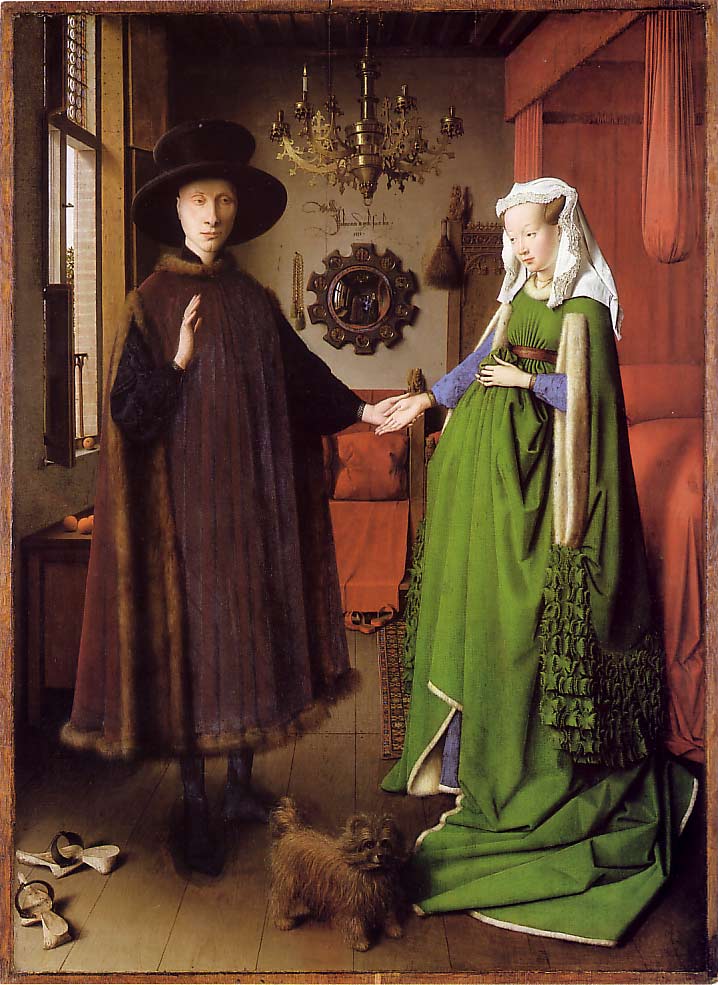Continuing our series looking at great paintings housed in London’s National Gallery…
When you enter room 56, tucked away in the farthest reaches of the Sainsbury Wing, chances are there’ll be a cluster of visitors obscuring your view of The Arnolfini Portrait. You might feel a bit sorry for the room’s other paintings: all lonely and neglected, like.
This is a justly famous and popular work. Depicting Italian merchant Giovanni Arnolfini and his wife, it dates to 1434 and, for its realism and depth, the contrast with other contemporary paintings is astonishing.
Most great paintings from the period, no matter how beautiful, are irredeemably flat, but Jan Van Eyck had a freakish mastery of painting light in oil. It is his treatment of light, rather than foreshortening, that gives the portrait its depth. For example, details such as the juxtaposition of the light outline of Arnolfini’s right shoulder with the dark shadow of his left create the illusion of, as one of the gallery’s guidebooks rather neatly puts it, ‘prising apart’ background and foreground. As well as light, Van Eyck recreates every surface texture convincingly – the rich cloth, wooden floorboards, the chandelier, the convex mirror, the hairy dog.
So much the textbooks will tell you. They’ll also tell you about the long and slightly ridiculous debate about supposed symbolism, particularly concerning the writing on the wall above the mirror (Wikipedia gives a potted history here).
What the textbooks won’t tell you, and what you can only discover for yourself by visiting the gallery, is the extreme daintiness of The Arnolfini Portrait. Despite the realism of Van Eyck’s technique, something is very odd about the subjects’ proportions. Their heads, feet and hands are tiny, trim and prim. So in fact rather than ‘realism’ we should say ‘brilliant illusionism’, because it is not a realistic portrait – rather, one believes it at the time, as one ‘believes’ a work of fiction while reading it.
Arnolfini and his wife look, and I can think of no better way of putting this, like a beautifully rendered pair of wee little pixies.









What I like about this series Brit – typified in today’s Arnolfini Portrait – is the opportunity it affords to consider a picture that you might be vaguely aware of, but have not invested the time or effort to think about. I like to imagine that yesterday’s Lazy Sunday slot performs a similar role.
I had never thought, for instance, about the size of their hands, and heads. The couple look weird and elongated to modern eyes, standing in the bedchamber, but is he performing some sort of blessing? And, if yes, is it for the child that she appears to be bearing under all that fabric?
to consider a picture that you might be vaguely aware of, but have not invested the time or effort to think about.
A key raison d’etre of the Dabbler, Mahlerman – as yr Lazy Sundays do indeed demonstrate…
I read somewhere that a textile historian (not a career path I knew was available) has discovered that the woman was not pregnant but just had to carry around yards of material like that, to display her husband’s wealth.
The van Eyck self portrait that hangs to the left of this is very, very beautiful too. If you get the National Gallery headphones guide, it is rather disconcerting to discover Brian Aldridge from The Archers is your companion in Room 56.
certainly one of my favourite paintings
Apparently she’s not pregnant, but fashionable. The picture is full of symbols of success and affluence.
As Mahlerman says, nice to be reminded of this picture and pause for a moment to consider its meaning.
Nice choice Brit, hard to believe its a fifteenth century picture, when it first touched down on the public stage everyone thought Touch of Honey…Murray Melvin, what’s he doing there. Evil looking critter, the cat or dog, dog with a cat’s face..cog maybe?
Also odd is a Rococo chandelier in the fifteenth century, at least according to Frau M.
Or possibly Taste of Honey
Certainly lots to puzzle about in this picture. But looked at simply as an object, it’s so exquisitely beautiful. In fact, its beauty is mysteriously transcendent. For instance, the chandelier, of all things, is rendered in such a delicate and lively way it becomes – inexplicably – quite moving.
Piero della Francesca’s Madonna del Parto (1467) gestures at her womb in a very similar way. It surely is a sign full of pregnant meaning. I can’t buy the argument that it’s just a fashionable wrestling with fabric. The man’s hand seems raised in benediction. Together the two gestures come together to convey something holy. It’s practically a nativity scene (some manger!).
I’m with you, LateAgitations – very hard to believe she’s not pregnant…